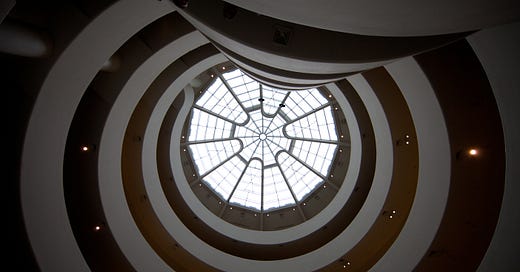"Off-Ramps," the Ascension, and the World to Come
She knows that the kingdom waits so high above her
In a recent intriguing discussion, Peter Thiel and Jerry Bowyer (click here to listen on YouTube) touched on Girard, the Bible, and the coming apocalypse and whether it could be avoided (light topics).
Thiel provided a high-level overview of Girardian thought through a quick exegesis of the Cain and Abel story in the Bible. Very quickly, Bowyer and Thiel began discuss the present age of the mimetic problem, in which there is some awareness of the innocence of the victim and the need to protect the victims in the post-Christian world, but the problem of mimetic rivalry with the added issue of a lack of true resolution through the old pagan sacrificial mechanisms still remains. We’re like the modern, hip vampires of Twilight: we may be “vegetarians,” but we still have a disordered bloodthirst that keeps us from being truly human.
Thiel and Bowyer describe the present situation, in which there are frequently mimetic problems, but no actual witch hunts in which real witches are burned at the stake to reconcile the community. The cat, to butcher an analogy to Schopenhauer’s, is neither in nor out of the bag. We seem to like the witch hunt, and we’re not afraid to shy away from mimetic problems, but we won’t quite go all the way anymore. We know a little bit too much. Our “Christ-haunted culture” has entrenched in us the need to defend innocent victims, but in our present aimless postmodernism, we’re willing to create new ones in the process. We are willing to “scapegoat the scapegoaters” as noted by Bowyer.
Neither will we quite move to forgiveness. As Bowyer noted, we know too much to apply the pagan remedy (an actual sacrifice) and we won’t apply the Christian remedy (forgiveness). This is the “sick revenge” as discussed by Bowyer and Thiel: a mimetically driven quest for revenge that feels like a weird, misfit hybrid that we always see at “the end of the world” as noted by Jonathan Pageau.
What is to be done with this sick revenge, this misfit, Pan-like hybrid? Is there a danger, as Thiel and Bowyer ask, of the present situation? Will it eventually fizzle out into forgiveness, will it remain as it is, or will it “snowball” into a larger, worse, “apocalyptic” scenario in which there is a horrible mimetic rivalry and a war of all-against-all? In the discussion, Bowyer asks if there is an “off-ramp” to this. Thiel responds, generally, with what I would characterize as some sort of negative reinforcement: that acting as if the apocalyptic ending will happen can cause people to act to prevent the apocalyptic ending from actual happening. They discuss Jonah’s preaching at Nineveh and the very preaching of the end of the world to Nineveh is what prevents the destruction of Nineveh.
Recently, Paul VanderKlay (Substack) posted a Rough Draft to Sunday on the Feast of the Ascension titled “Can You Get to Heaven by Flying Up in the Sky?” (click here to watch/listen on YouTube) In it, he pulls together ancient “maps” which conceive of the known material world in which we live and abide as being some place in the “middle,” Sheol/hell/Hades somewhere below, and some sort of “heaven” like place up high above. In our post-modern, post-scientific and -rationalist world, we have to process the Ascension of Jesus into Heaven (after He spent 40 days with his disciples in the post-Resurrection period) with this odd idea of Jesus floating up into the clouds as if He were some sort of actor on wires in a stage production of Peter Pan. It seems that Jesus was perfectly capable of Apparating, Harry Potter-style, here and there in and out of rooms and places in His post-Resurrection body, and why He needs to float up to Heaven rather than snap His fingers to get there is unclear.
There may be a better way to conceptualize the current problem of “sick/hybrid/enfeebled revenge” (I’m not sure which term I prefer the most, I’ve added my own after the “sick revenge” term discussed by Thiel and Bowyer) than as something that needs an “off-ramp.” I’m not sure that the Christian project of revealing things hidden since the foundation of the world can ever stop, at least not until the end of time. It is, like the interior of the Guggenheim Museum shown in the photo attached to this post, a constant spiral upward around a fixed center. I borrow this imagery from Pageau, who constructs the idea of salvation this way, in which we come closer to the center of Christ and then spiral away, and then back. The salvation of the world may be just that, at scale. The first persecuted Christians reveal to the Romans the truth of the innocent victim; then, the persecuted Jews at the hands of the Christians of the Middle Ages eventually reveals the same; this goes on to the burning of women by Puritans in the 1600s and on, and on, and on.
Eventually, we learn. We know now that the persecution of the Christians, the Jews, and the scapegoated women were all inhumane. We remain half-blind at what we might be doing where we are demanding sacrifice rather than offering mercy, but our children and our children’s children and so on will learn more about where we made these missteps. But, I believe that if we’re zealous not for the avoidance of apocalypse but for the first fruits of the coming world, we can continue to travel this spiral up, up, up, upward to the Kingdom of Heaven.




